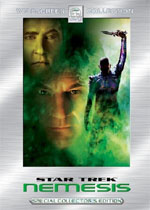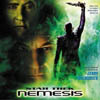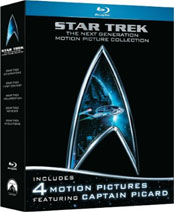
STAR TREK:
- The Original Series (TOS)
- The Animated Series
- The Movies
- The Next Generation (TNG)
- Deep Space Nine (DS9)
- Voyager
- Enterprise

Star Trek Movies:
1. The Motion Picture
2. The Wrath of Khan
3. The Search for Spock
... Prime Directive: Genesis
4. The Voyage Home
5. The Final Frontier
6. The Undiscovered Country
7. Generations
8. First Contact
9. Insurrection
10. Nemesis
11. (untitled)
12. Into Darkness

SCIENCE FICTION:
- Doctor Who
- Sliders
- The Matrix
- The Matrix Reloaded
- The Matrix Revolutions

- Main Index
- Site Map
|
Star Trek 10: Nemesis
story by John Logan, Rick Berman and Brent Spiner
screenplay by John Logan
feature film, 116 minutes

|
The Next Generation team did themselves proud yet again with
another highly entertaining and professional feature film,
which I wholeheartedly enjoy. However, it does remain less
memorable than most of the others simply due to the fact that
it is by far the least original, as most of its best portions
are easily traced back to previous films or episodes.
The heavy plundering of Star Trek II: The Wrath of Khan
is the most obvious, from angling the main conflict to
be a battle between the Enterprise and another ship,
to trying to outdo Khan with a huge villain deeply connected
to our hero, to the all-too-careful set-up of another temporary
"we didn't really mean it" sci-fi death for one of our regulars.
Of these, the space battle is the most welcome, since this is
an element that had perhaps not been focused on too much
since Star Trek II, and this film came up with a much-talked-about
new twist on it.
|
But the moviemakers' need to have the big space battle with
the big "villain" seems to have limited the avenues in which
the film's really original ideas might have gone. Picard's clone
would probably have been more interesting if featured
over a number of TV episodes while exploring a variety of
issues and triumphing over some of them positively.
It was really great to finally see the Romulans take their rightful
place in the features, and to explore not only their culture,
but that of the Remans, whose planet had been mentioned a few times
but largely ignored. All good stuff, which again could have been
really interesting if not formulaically plodding down the most
predictable path possible.
My biggest beef with what we do get in this film all surrounds
the believability of B4's participation in the main plot,
which stretches credulity at every turn. Firstly, his existence
grates terribly against the supposed rarity of Soong androids.
Secondly, it's very far-fetched to think that Shinzon would come
across one before anyone else - his only real opportunity would
have been during one of his campaigns in the Dominion wars
when he had access to Federation space, and surely he would
be occupied by other concerns at such a time. Thirdly, the
idea that the Enterprise could detect the pieces from several
star systems away, without actually having any interest in looking
for them, is another stretch. But worst of all, the villain's
whole plan seem to hinge on the idea that the Enterprise crew would
not only discover this android but also divert themselves to
pick it up, put it together, and let it loose on their ship, all on
a schedule that fits seamlessly with the rest of Shinzon's plans.
This is just taking it way too far for me.
How can he credibly depend on such a complicated
and almost random sequence of events being carried out by people
he has no real influence over, while keeping his desire for that
sequence of events a secret from them?
It's bad enough when "deus-ex-machina"
pops up in a screenplay to get the protagonists out of trouble,
but when the villain's plan needs "deus-ex-machina" in order to work,
it doesn't actually work at all. Any slight random variation in the
protagonists' actions, which is HIGHLY likely in this case, will
render the whole plan useless. Only in fiction can it all work
out so nicely.
And of course, the whole real reason for using B4 as the villain's
tool in this film is to allow Data to give us a re-run of Spock's
temporary death.
REALLY not worth it. If you're not going to be serious about
Data's death, don't bother going through the motions.
The concept of Data encountering brotherly (or even daughterly)
Soong androids had
also been covered fairly extensively and fairly well over the
course of many episodes of the Next Generation series, and it
really doesn't feel like any important new ground is covered
here in this film.
There's another important nail in B4's coffin that probably few
viewers will have noticed. In order for the Enterprise to find B4,
Shinzon apparently places him on a planet with a
pre-warp civilization (who like their dune-buggies).
The Prime Directive should prevent the Enterprise crew from
going down to the planet. They completely disregard this consideration
without making any mention of it. Perhaps they think the Directive
doesn't count because they are only wandering around in the desert
collecting artefacts, and maybe they'll just as soon do that as
spy on other cultures with duck blinds.
But how can they assume that the positronic
signature isn't either indigenous to the planet's culture, or part
of a symbiotic cultural system as was the case in the animated episode
"Bem"? Or perhaps the Prime Directive
has been thrown out in the years between the end of Deep Space Nine
and this solitary adventure at the farthest end of Star Trek's future
that we've seen so far on screen? Anyway you slice it, the immediate
descent into a shootout in dune-buggies is far less than an ideal
first-contact performance for Picard and company, grating against
the boasts he made during his opening Best-man speech at the wedding.
I think the timing of Shinzon's illness is also unbelievably
convenient, leaving him looking normal for all the years
leading up to the opening of the film, and then taking him down
to an obvious near-death look during the few days over which
the film takes place.
To give credit where credit is due, I think the energy of the film
takes over and helps mask the holes of character logic in the plot.
Stuart Baird's extensive editing experience has led him to become
an outstanding director, as evidenced here, and indeed this film
seems to have more polished picture and sound editing than its
predecessor. However, the pace seems to depend on editing a little
too much for my tastes, and I think Jonathan Frakes has a better
instinct for composing action shots that stand on their own.
The more any one shot can excitingly tell you what's going on,
the longer you can hold it, and the longer a span of attention
you can command, which is a noble aim. Food for thought.
I think we should also note that this film delivers something
that "The Wrath of Khan" only teased us with, and that is good
face-to-face confrontation between hero and villain.
Tom Hardy really does excellent, energetic work with a role that
automatically carries high expectations and increased scrutiny
and he does it so well, especially opposite Patrick Stewart.
The two have a lot of great scenes together which spark
with high voltage and depth, and are very satisfying from a
dramatic point of view. Philosophically, a lot of obvious
potential goes unrealized, however.
The concluding dynamics work well for a standalone film,
but let's not pretend we haven't seen it before,
as the elements greatly resemble those of Star Treks 7, 9, and 2.
One still can't deny the satisfaction of this higher energy level
though, or the use of a formula that pretty much always works.
|
With this film, music composer Jerry Goldsmith has hit
his third home run in a row. Excellent new bits include some
nicely bizarre synthetic percussion for the discovery of the
new android, plus some cool rousing Romulan music. It's strange
that the big screen Klingon theme had been with us since 1979,
while it took another 23 years to get to the Romulan equivalent.
Far too long, meaning that in the long run, Fred Steiner's theme
from the original series may remain more definitive in spite
of its being shared with mirror universe empires and any villain
of the week that needed a reliable stock music track.
Sadly, "Nemesis" just doesn't have the kind of content that would
inspire the more beautiful types of Jerry Goldsmith melodies that
both "First Contact" and "Insurrection" became famous for. Here,
the closest approximations come from heartfelt repeats of
well-established Star Trek anthems and the four-note Sybok motif.
It's a great, enjoyable, moving score in the end, but still
necessarily eclipsed by the music of the previous two films
due to the very nature of what it had to be to make this movie work.
|
|
|
Don't get me wrong; I like this film. It's a great ride with
my favourite Star Trek cast. But of the four
Next Generation films, it ranks third behind the previous two
Jonathan Frakes films, with all of these top three films being
quite far ahead of the disastrously misconceived "Generations".
Read the next Star Trek review:
"Deep Space Nine: Emissary"
(Or, skip ahead to the next feature film:
"Star Trek Eleven" by J.J. Abrams)
Star Trek 10 is available in various incarnations on DVD and Blu-Ray.
Click on the Amazon symbol for the desired disc format
and location nearest you for pricing and availability:
2-disc DVD Special Collector's Edition
DVD U.S.


| DVD Canada


| DVD U.K.


|
DVD Extras include:
- Audio commentary by
director Stuart Baird.
- Audio commentary by producer
Rick Berman.
- Okuda text commentary
- "Nemesis Revisited" making-of featurette (26 min.)
- 6 additional production featurettes (45 min.)
- 3 Star Trek universe featurettes (37 min.)
- 5 Romulan Empire featurettes (53 min.)
- Deleted scenes (27 min.)
- Storyboards, Photo Gallery, & Trailers
- Easter Eggs
|
1-disc Blu-ray
Blu-ray U.S.


| Blu-ray Canada


| Blu-ray U.K.


|
Blu-ray Features add:
- New Commentary by Michael and Denise Okuda
- Reunion with the Rikers (HD)
- Today's Tech Tomorrow's Data (HD)
- Robot Hall of Fame (HD)
- Brent Spiner: Data and Beyond Part 4 (HD)
- Trek Roundtable: Nemesis (HD)
- Starfleet Academy: Thalaron Radiation (HD)
|
Article written by Martin Izsak.
Comments on this article are welcome. You may contact
the author from this page:
Contact page
|





 from the U.S.
from the U.S. from Canada
from Canada from the U.K.
from the U.K.




